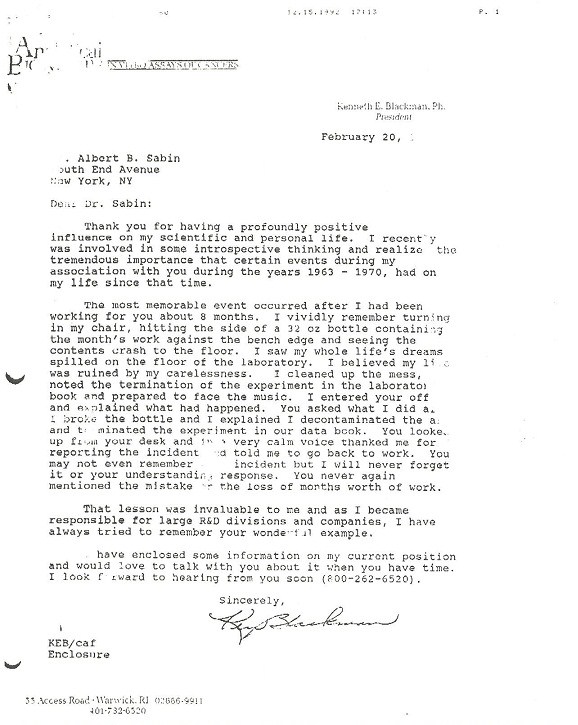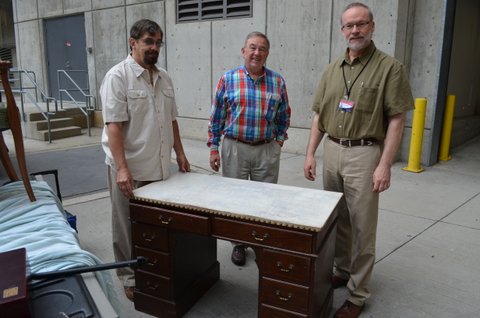By Richard Jason Sookoor, Sabin Project Student Assistant

A letter written in 1992 to Dr. Sabin from Dr. Blackman regarding the incident roughly 30 years prior. Their correspondence over the next few months would last until Dr. Sabin's passing in 1993.
Successful people are often described as being driven, strong-willed, or zealous. Though to be definitively admirable, a person should also be compassionate, forgiving, and considerate. Dr. Albert Sabin managed to find a steady balance between these two domains, stern yet soft. In speaking with Dr. Kenneth Blackman, a former assistant to Dr. Sabin, we gain some insight on the level of professionalism and empathy shown by Dr. Sabin.
As the story goes, Dr. Blackman, then a young man with an opportunity to work in Dr. Sabin’s lab, was busy working on a project related to a potential human tumor virus. Dr. Blackman’s duties were to properly identify and collect concentrates in fluid from tissue culture infected with this particular virus. Despite the relatively cramped working space (Old Children’s Research Building R), Dr. Blackman was able to complete this rather standard collection with nary an incident for weeks. On a particular day though, a Friday, things took a heartbreaking turn for the worse. Dr. Blackman, completing the daily collection of concentrates from tissue culture, was steadily handling a bottle containing a few weeks’ worth of sample liquid. Bottle in hand, as he was turning towards away from the tissue culture station, the bottom of the bottle clipped the edge of the work bench causing the contents to fall out.
A few weeks of meticulous work destroyed in few seconds. This project, a novel endeavor within medicine, was ultimately halted by a single innocent mistake on an otherwise routine day. Dr. Blackman, stunned but composed, calmly cleaned up the fluid and glass and proceeded to log the event in the lab notebook. Though the research was seemingly unrecoverable, his major concern was bearing the news to Dr. Sabin.
Luckily, or perhaps unluckily, Dr. Sabin was lecturing to students for the next two hours or so, giving Dr. Blackman time to contemplate his fate. As the end of the day came near, Dr. Blackman decided now was the best time to break the news. While approaching Dr. Sabin’s office, a flurry of thoughts ran through Dr. Blackman’s mind. Of course, he thought, he would be terminated without delay. He had three young children at home; he had to provide for them somehow. His major reason for moving to Cincinnati was to work for Dr. Sabin, what would he do now as the man is about to fire him? Things seemed uncertain, but his only choice was to confess and accept the outcome.
Sheepishly knocking on Dr. Sabin’s door bought him an invitation into his office. Upon entering, Dr. Blackman stood silent with nervous anticipation for a few moments. Dr. Sabin looked at his young assistant and inquisitively said, “Yes?” Dr. Blackman gingerly stated that there had been a mishap in the laboratory that day, to which Dr. Sabin pressed him to go into detail. Dr. Blackman recounted the events that caused the destruction of his work. After hearing and explanation of the incident, Dr. Sabin inquired, “. . . and then what did you do?” Dr. Blackman recalled the measures taken to clean up the spill, the records made in the lab notebook, and finally the report made to his superior, Dr. Sabin. To this, Dr. Sabin calmly replied, “Thank you very much, have a nice weekend.”
Dr. Blackman professes that the incident was never mentioned again and that Dr. Sabin hadn’t thought ill of him because of it. Work continued as usual, Dr. Blackman had no reason to fear any retribution or delayed reaction to the accident. Though the experiment was unable to be recovered, Dr. Blackman was not to be persecuted for the simple accident.
To ardently work towards a goal and recruit associates to help with the endeavor is notable. However, hearing that a year-long endeavor had been dashed within a manner of seconds by a trusted colleague can be truly heartbreaking. Though handling such an incident in stride, forgiving a person for a simple mistake, and never losing faith in them is praiseworthy—and truly admirable.
Dr. Blackman kept in contact with Dr. Sabin throughout the years on both a personal and professional level. This particular story is one Dr. Blackman retells in regards to Dr. Sabin’s influence over his life and career. Dr. Blackman had delivered a desk belonging to Dr. Sabin to the Winkler Center a little over a year ago, and this was one of the first stories he told in reference to his time with Dr. Sabin. The desk will soon be on display at the Winkler Center commemorating the completion of the digitization project.
Note: The majority of this information is from an interview with Dr. Kenneth Blackman which was conducted on Tuesday, July 17, 2012. The letter seen above can be found in Series #1 – Correspondence, Sub-series – Individual, Box 2, Folder 20 – Blackman, Kenneth E., 1992-1993.
In 2010, the University of Cincinnati Libraries received a $314,258 grant from the National Endowment for the Humanities (NEH) to digitize the correspondence and photographs of Dr. Albert B. Sabin. This digitization project has been designated a NEH “We the People” project, an initiative to encourage and strengthen the teaching, study, and understanding of American history and culture through the support of projects that explore significant events and themes in our nation’s history and culture and that advance knowledge of the principles that define America. Any views, findings, conclusions, or recommendations expressed in this blog do not necessarily reflect those of the National Endowment for the Humanities.

